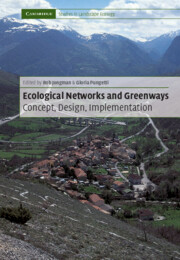Book contents
- Frontmatter
- Contents
- List of contributors
- Foreword
- Preface
- Acknowledgements
- 1 Introduction: ecological networks and greenways
- 2 The context and concept of ecological networks
- 3 Greenways in the USA: theory, trends and prospects
- 4 Ecological functioning of ecological networks: a species perspective
- 5 Impacts of roads on ecological networks and integration of conservation and transportation planning: Florida as a case study
- 6 Ecological corridors on a European scale: a typology and identification of target species
- 7 Planning the future landscape between nature and culture
- 8 From models to reality: design and implementation process
- 9 Design of the Pan-European Ecological Network: a national level attempt
- 10 Ecological ‘black spots’ within the ecological network: an improved design for rural road network amelioration
- 11 An ecological network for the Milan region based on focal species
- 12 Connecting corridors: implementing metropolitan greenway networks in North America
- 13 The Florida Statewide Greenways Project: its realisation and political context
- 14 The ecological network development in the Yungas, Argentina: planning, economic and social aspects
- 15 The river corridor of the Guadiamar
- 16 Conclusions: into the twenty-first century
- References
- Index
2 - The context and concept of ecological networks
Published online by Cambridge University Press: 29 December 2009
- Frontmatter
- Contents
- List of contributors
- Foreword
- Preface
- Acknowledgements
- 1 Introduction: ecological networks and greenways
- 2 The context and concept of ecological networks
- 3 Greenways in the USA: theory, trends and prospects
- 4 Ecological functioning of ecological networks: a species perspective
- 5 Impacts of roads on ecological networks and integration of conservation and transportation planning: Florida as a case study
- 6 Ecological corridors on a European scale: a typology and identification of target species
- 7 Planning the future landscape between nature and culture
- 8 From models to reality: design and implementation process
- 9 Design of the Pan-European Ecological Network: a national level attempt
- 10 Ecological ‘black spots’ within the ecological network: an improved design for rural road network amelioration
- 11 An ecological network for the Milan region based on focal species
- 12 Connecting corridors: implementing metropolitan greenway networks in North America
- 13 The Florida Statewide Greenways Project: its realisation and political context
- 14 The ecological network development in the Yungas, Argentina: planning, economic and social aspects
- 15 The river corridor of the Guadiamar
- 16 Conclusions: into the twenty-first century
- References
- Index
Summary
Introduction
Niels Holgerson travelled on the back of his goose with the wild geese to the north to the breeding areas and he saw the land beneath him. Geese fly north and south for breeding and wintering. When walking in a forest or through agricultural land you may suddenly meet a deer, a badger, a hare or a rabbit. Looking carefully in the grasslands in the wintertime you can detect mouse tracks. Salmon migrate from the ocean up the rivers for spawning. Humans used to walk or drive horses to travel for business and religious purposes. In the modern western world, humans walk mainly to enjoy a tour on a grande randonnée or a old pilgrims' path. However, in general connection and exchange are important for all species to survive, to forage, to reproduce or establish new communities. On all scales and for most species pathways do exist to link individuals and populations.
Land use and nature changed dramatically in the nineteenth century. The land has been developed, parcels enlarged and land use intensified. Since the end of the nineteenth century nature conservation through national parks and nature reserves has been the prime tool to counteract decline of species and natural ecosystems. This was very important to preserve species and natural ecosystems. In that period the linkage between protected sites did not seem to be crucial. The increasing pressure of land use in combination with the insights from landscape ecology on the role of landscape flows and the functioning of metapopulations of species has changed that idea.
- Type
- Chapter
- Information
- Ecological Networks and GreenwaysConcept, Design, Implementation, pp. 7 - 33Publisher: Cambridge University PressPrint publication year: 2004
- 16
- Cited by



